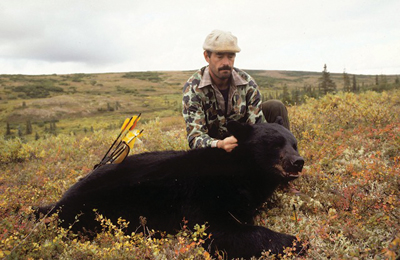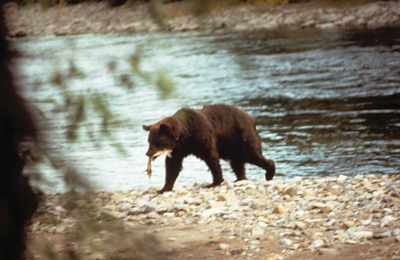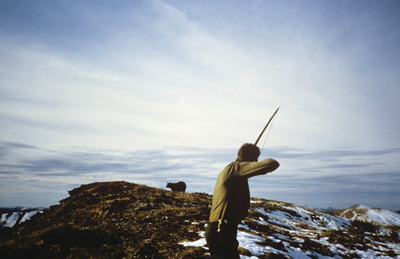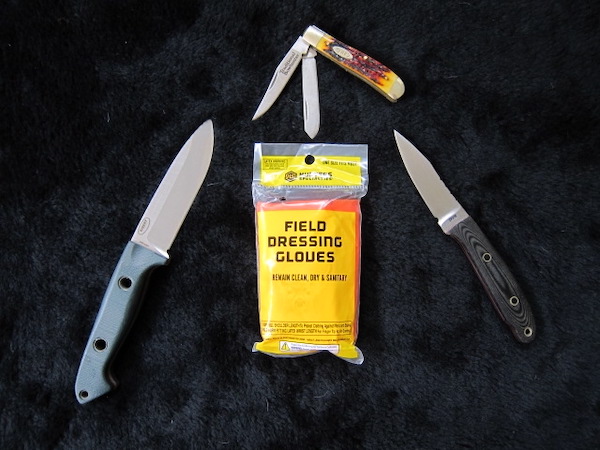Anyone who spends time afield in Alaska should be acutely aware that they are sharing the environment with black, brown, and grizzly bears, prevalent along any stream that has a salmon run, in the alpine blueberry patches, and from the tidelines of the Southeast panhandle to the slopes of the Brooks Range. Not only that, as my cell-phone photo of a brown bear in our back-yard flower bed can attest, bears in Alaska also frequent the edges and suburbs of most Alaska cities, towns, and villages.
Grizzly numbers in the Rocky Mountains are increasing, while black bears range from Maine to California and are present in at least 40 states in the Lower-48 and most of Canada. Encounters between humans and bears in the wild anywhere in North America, not just in Alaska, are increasing.

The author with a black bear taken on the Moose John River, 1987.
A few headlines from just this summer can illustrate the realities of sharing habitat and mixing with bears in their home environment:
“BOWHUNTER SURVIVES ATTACK IN MONTANA WILDERNESS”
“GRIZZLY MAULS RAFTER AFTER MAKING CAMP ALONG COPPER RIVER”
“TEENAGER RECOUNTS BEAR ATTACK IN NAKNEK”
“MAN KILLED AND SEARCHER INJURED IN EAGLE RIVER BEAR ATTACK”
“HUNTING GUIDE KILLED AND HUNTER INJURED BY WYOMING GRIZZLY”
These reports tend to get sensationalized and the reaction to them can be out of proportion to the reality, but any bowhunter who spends time in the woods where bears are present needs to be acutely aware that there can be encounters and situations that can turn from benign to dangerous to deadly for the hunter in a hurry!
Bear encounters are to be expected in Alaska’s outdoors, but those of us who have spent a lot of time in the wild over the years, including me, tend to feel inoculated against the risk of sharing bear habitat. However, taking bears for granted is certainly not the best approach. As sharks are to divers, bears deserve respect as apex predators, but the fact that they might kill you doesn’t mean that we shouldn’t share common grounds.
A review of the records on bear maulings reveals that since 2000 there have been 46 fatal attacks by bears in North America. Nineteen were in Canada, 17 in the Lower-48 states, and ten were in Alaska. Interestingly, the deaths were distributed about equally between grizzly bear and black bear attacks, which belies the notion that grizzlies are much more dangerous. Indeed, brown and grizzly bears are considered to be more aggressive, but the fact that there are hundreds of thousands more black bears affects the statistics. Conventional wisdom in Alaska suggests that while a grizzly may attack, its attack is less likely to result in death of the victim than an attack by a black bear. While a black bear may stalk and attack a person as food, there has been only one confirmed case in Alaska of a brown or grizzly bear attacking and killing a human as food. Black bears can indeed be very dangerous, especially in years of poor berry crops or other food shortages.

In a stand off with a silverback grizzly.
In Alaska, there have been only six fatal bear attacks in the last ten years (three by black bears), but non-fatal attacks are much more numerous and much harder to verify. Many go unreported, and many reported attacks are simply bluff charges or exaggerated encounters. As the number of outdoor users increases, it is inevitable that more encounters will result in outright attack. Hunters and anglers in Alaska are potential attack victims, and bowhunters specifically seem to experience more than their share of bear maulings. I personally know of two bowhunters who have been severely mauled in Alaska and several others who have been attacked but somehow avoided being mauled. Perhaps this reflects our tendency to hunt alone and quietly plus the need for up close encounters while pursuing big game with traditional equipment.
Which leads to the questions on every backcountry bowhunter’s mind before venturing into bear country: How can I avoid a bear encounter, and how can I be best prepared if I do encounter bears?
Bear avoidance begins by simply being “bear aware.” There are two main situations to avoid: attraction and aggression. Black bears especially are attracted to human food, so maintaining a clean camp is absolutely essential. Avoiding food consumption in the tent where you are sleeping, having a separate cooking shelter, and storing food in bear-proof containers or cached high out of reach are well-founded although not always practical rules.
The new electrical “bear fences” are getting good reviews here in Alaska. They allow you to completely surround your tent site with a portable electric fence that should deter a bear from entering inside the area. As with all electronics, depending upon them exclusively has limitations: the fences can be installed improperly, short-out in wind or rain, or be damaged and rendered inoperable by animals that encounter them. Carrying the batteries they rely on is cumbersome, and they can run out. On a recent hunt, my companion, a pilot, was meticulous about setting up his bear fence around his airplane, our only ticket out of the bush. You would have to ask him why he used the fence for his plane but not around the tent where he and his wife were sleeping!

Getting between a bear and its food source is a recipe for disaster. Salmon and steelhead runs, both spring and fall, draw bears from all over to load on fat for winter.
Regarding aggressive bears and how to avoid them, a sudden encounter at close range offers the absolute highest risk for attack. Maternal instinct will take over when a hunter stumbles over sows with cubs at close range, and bears protecting a food cache can be particularly aggressive. A bear you have just “bumped” into can instinctively lash out when surprise triggers a “fight or flight” response.
Therefore, always approach downed game on high alert for bears, and when packing game understand that bears’ sensitive noses can detect the scent of fresh meat for miles downwind. We always mark our gut piles with highly visible flagging in case an unsuspecting hunter later wanders into the kill site where a bear might be on the remains. Bear-baiting by hunters is especially controversial in states like Alaska where grizzly and black bear overlap. Bait sites need to be well away from human habitat or trails and roads where habituated bears might encounter innocent campers and hikers. Of course, a wounded bear can be the most aggressive of all. The obligation to track and follow up on an arrowed bruin in brush has always given me pause and called for the utmost respect for the situation’s potential danger.
We always camp well away from bear trails and heavily used areas along salmon streams. Being vocal when traveling in brush or areas where visibility is limited is a common recommendation but isn’t very practical for a bowhunter who might be sneaking on game or still-hunting. When just traveling by foot though, we avoid sudden encounters by constantly making noise in the brush.
“Bearanoia” affects different people different ways. As mentioned, I am probably too complacent in the woods, regarding black bears and even grizzlies as just another species of critter that’s always around. But I have been encountering bears up close for over 40 years and think that I am extremely “bear aware” and conscious of possible situations that could lead to a bad encounter.
Along with my regular group of bowhunting friends in Alaska, I usually choose to bowhunt without carrying a firearm, even in known grizzly country. Usually we have a “camp” gun or a “boat” gun that is capable of stopping any big bear in a bad situation. We keep it close in camp and carry it when returning to downed game or packing meat.
I have never carried or used pepper spray as bear attack protection. That’s not to say that in certain situations it can’t be a good deterrent, as anecdotal evidence has long touted its effective use in the field in Alaska and elsewhere. Many outdoor users are not well-versed in the use of firearms, and for sure bear spray can prevent a close-range situation from deteriorating into an outright attack. Any bear “nosing around” a tent or in camp looking for food is a prime candidate for bear spray. Limitations include its short range, its use in high winds that restrict effectiveness, and legitimate questions about its stopping-power in the face of an enraged bear at close range in full charge. Some bears have been effectively run off by a second hunter using bear spray as the first was being mauled, as happened recently to bowhunters in Montana. Like firearms, if you rely on bear spray it should be with practice using it in a variety of conditions. For me, if the chips are down, I would rather defend myself with my 45-70 carbine or my 12-gauge with double-ought buckshot.
Fortunately, after encountering hundreds if not thousands of bears in all situations, from stalking them and getting “busted,” to having them come inadvertently to my moose calling, to hungry bears in camp, to numerous “sudden encounters,” I have only seen two situations in which an aggressive bear (both grizzlies) actually attacked.

Anytime you are hunting in the backcountry where bears live, it is advisable to hunt in pairs, and with some sort of bear defense. A large caliber handgun, riot shotgun loaded with buckshot alternated with slugs, or, at a minimum, up to date pepper spray are in order along with a strong dose of situational bear awareness.
The first occurred in low evening light during a remote river float trip for moose in Alaska’s interior. I had stepped out of my raft and scrambled up the river bank looking for a good camp site. Finding it too brushy for a decent camp, and making the mistake of not making plenty of noise, I turned around to go back to the raft and saw a beautiful big silvertip Alaska grizzly looking off of the bank at the raft below the bank I had just climbed. My rifle was in the raft, and I hollered to my hunting partner: “Get the gun, there’s a bear and he is right here!” The bear turned at the sound of my voice, our eyes met, and he charged. It is true that time slows down during extreme stress, and he bounded to me from under 30 yards in a flash that seemed like forever. I had no time to turn and climb a tree, no weapon, nothing but my loud scream and bracing for the impact. Something—the desperate scream, me standing my ground, him identifying me—deterred him at the last second as he brushed by me at arm’s length and crashed away. I still think he mistook me for a caribou or some easy prey until the last instant, and in that remote location bears could have easily never encountered a man before. We did not camp until we were at least five miles downstream, and the last of our Yukon Jack disappeared during the mostly sleepless night that followed.
The second personal attack was indeed nearly in my backyard, here in Sitka on Baranof Island, where large brown bears are prevalent and seasonally concentrated on our rich salmon streams. Almost every year there is at least one attack in our area, usually involving a hunter, angler, or hiker who got into a compromising situation by invading the bear’s natural environment. I was by myself on a highly used trail close to my house, hiking after work to get in some exercise. Visibility is restricted along that trail due to second-growth evergreens and alders. Adding to the undergrowth are dense salmonberry patches, bushes which were fruiting at the time and a favorite food of bears. As I rounded a turn in the trail, I saw a sow and cub grizzly pop up about 60 yards away.
I stopped unobserved as a second, third, and, to my surprise, fourth cub appeared at her side. It is quite unusual for brown bears to have four cubs of the year; and she was having her hands (paws?) full trying to control them as they scampered and scrambled between her legs. I started to back away slowly (running, never a good option, can trigger the predator-prey response). When one of the cubs started coming my way, the sow saw me and immediately charged. In retrospect, I did everything right at the time. I did not run away, made myself as “big” as possible by standing tall, facing her holding my arms above my head, and shouting as loudly as possible. It did not feel like a “bluff-charge” when she skidded to a stop a mere 15 feet away, whoofing, growling and popping her teeth. With too many cubs to handle, she pushed them back into the brush while I had an adrenaline overload and tried to regain my composure. Incidentally, this same bear was killed by wildlife protection officers a few days after my encounter when she attacked and mauled a lady mountain biker on the same trail!
As I finish writing this piece, I am learning via news feeds that just yesterday a bowhunter survived a grizzly bear mauling while hunting elk near Yellowstone Park in Montana. Yet, I will still continue to spend weeks every year in Alaska’s bush, sharing the habitat of Ursus arctos and Ursus americanus, recognizing that the existence of these apex predators can only add to the richness of my experience. As always, I will remain bear aware.
A longtime Alaska resident and past president of the Professional Bowhunters Society, Doug Borland has spent more than his share of time in bear country.
Bear Spray: Hype or Life Saver?
Doug Borland is an old friend and longtime hunting partner, and we have spent a lot of time together in bear country. While I agree with everything he has written here, I have a bit more confidence than he does in bear spray as an effective deterrent against bear attack.
As is so often the case in uncommon outdoor situations in which rigorous scientific study is impossible, my opinion about bear spray arises from a single personal incident. I’ve told the story before and won’t repeat it here, but in this case, spray was dramatically effective in sending an aggressive, steadily advancing brown bear galloping away at high speed. Spray may or may not have saved me, but it certainly saved the bear, who was about two steps away from getting a lethal bullet.
That’s no small consideration. Alaska law allows you to shoot a bear in self-defense, but you had better be able to prove it was the real deal in the face of a serious investigation. Too many hunters with limited bear experience shoot bears in situations that really weren’t threatening at all, and law enforcement knows it.
It’s not always easy to distinguish a bluff charge from the beginning of a serious attack. Waiting to see whether or not the bear is going to break off can be an unsettling experience. Spray provides an option appropriate to both outcomes on the part of the bear.
As a physician, I was taught not to depend on evidence derived from isolated anecdotes. Had the bear we sprayed that day kept coming and wound up being shot and killed, I’d be claiming that bear spray is worthless. That’s not the way events played out, so I’m taking the opposing position.
Don Thomas







Leave A Comment